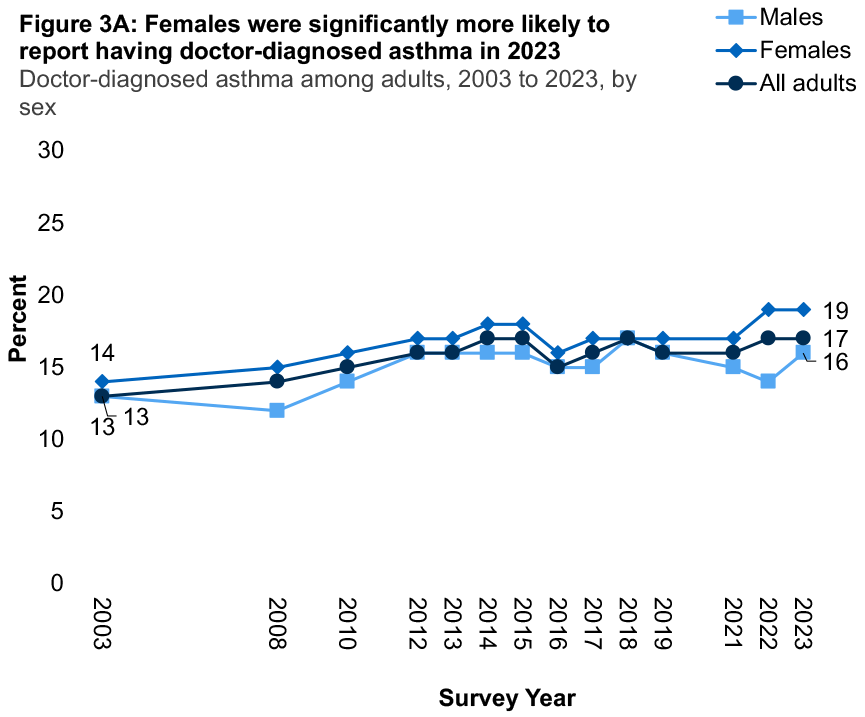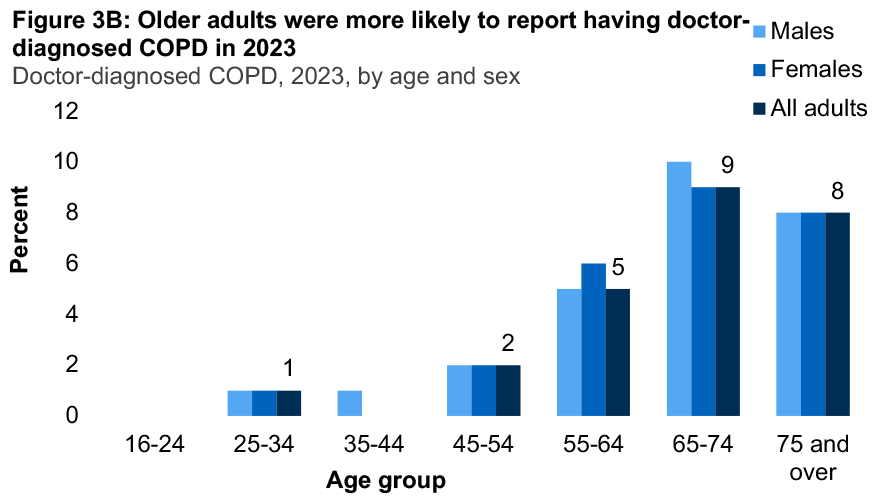The Scottish Health Survey 2023 - volume 1: main report
This report presents results for the Scottish Health Survey 2023, providing information on the health and factors relating to health of people living in Scotland.
3 Respiratory
Sophie Birtwistle
3.1 Introduction
Infectious respiratory disorders and long-term respiratory conditions, such as asthma and chronic obstructive pulmonary disease (COPD), are a considerable challenge for the individuals that live with them and for health services in Scotland, particularly in light of an ageing population [57]. Chronic respiratory conditions are currently incurable, however, treatment can help to improve symptoms and quality of life[58].
The UK has one of the highest rates of asthma in the world[59]. Asthma is a long-term condition characterised by variable and recurring breathlessness, wheezing, coughing and chest tightness. The reasons for the high prevalence of asthma in the UK are not certain; however, risk factors include infections/viruses, hormones, environmental, lifestyle (including smoking, diet and obesity), occupational and genetic disposition[60],[61],[62]. An estimated £500 million is spent by the NHS in Scotland each year on this and other respiratory diseases[63].
COPD continues to be the third leading cause of mortality worldwide[64]. The ageing population, along with the additional complication of older COPD patients being more likely to have other long-term conditions, presents a further challenge in managing COPD in Scotland[65]. Smoking is the main cause of COPD with an estimated 8 in 10 of those with the condition in the UK having either smoked or continuing to smoke[66]. Exposure to smoke is associated with a higher risk for females compared to males[67].
Long COVID, or post-COVID-19 syndrome, refers to symptoms that develop during or after a COVID-19 infection that continue for 4 weeks or more and are not attributed to another condition/diagnosis. The overlapping long COVID symptoms that are sometimes experienced can affect body systems including the respiratory system[68]. The ongoing impact of long COVID can be debilitating for some with impacts on daily activities and quality of life reported to include fatigue, breathlessness, anxiety, depression and cognitive dysfunction[69].
3.1.1 Policy background
The Respiratory care – action plan: 2021 to 2026[70] sets out the vision for improvement in the prevention, diagnosis, care, treatment and support of people living with respiratory conditions in Scotland. This is supported by other key policy initiatives including the Special Delivery Group within the Centre for Sustainable Delivery[71], which aims to improve patient journeys through sustainable changes that facilitate person-centred care and the Framework for supporting people through Recovery and Rehabilitation during and after the COVID-19 Pandemic[72].
In September 2021, the Scottish Government published Scotland’s Long COVID-19 Service[73] paper. The paper sets out four key elements that underpin the approach to care and support for people with long COVID: supported self-management, primary and community-based support, rehabilitation support and secondary care investigation and support.
The Scottish Government has established a £10 million long COVID Support Fund to support NHS Boards and partners increase the capacity of existing services providing support to people with long COVID, develop these into more clearly defined pathways and to provide a more co-ordinated experience for those accessing support[74].
3.1.2 Reporting on respiratory conditions including COVID-19 in the Scottish Health Survey
In this chapter, the following data are presented:
- self-reported doctor-diagnosed asthma for adults and children
- self-reported doctor-diagnosed COPD for adults
- self-reported long COVID for adults and children and its day-to-day impact on adults
Figures are reported by age, sex and area deprivation.
The area deprivation data are presented in Scottish Index of Multiple Deprivation (SIMD) quintiles. To ensure that the comparisons presented are not confounded by the different age profiles of the quintiles, the data have been age-standardised. For a detailed description of both SIMD and age-standardisation as well as definitions of other terminology used in this chapter and for details on the data collection methods for respiratory conditions and long COVID, please refer to Chapter 2 of the Scottish Health Survey 2023 - volume 2: technical report.
3.1.3 Comparability with other UK statistics
The latest asthma prevalence estimates for both adults and children in England were collected in the 2018 Health Survey for England [75]. The survey has a different sampling methodology to the Scottish Health Survey, so asthma prevalence estimates across the surveys are only partially comparable. There are no comparable statistics collected in Wales or Northern Ireland.
Long COVID prevalence estimates from the UK-wide ONS Coronavirus (COVID-19) Infection Survey[76] for Scotland, Wales, England and Northern Ireland should be fully comparable.
3.2 Results
Summary points
In 2023:
- The proportion of adults reporting having doctor-diagnosed asthma (17%) remained in line with prevalence levels since 2017 (14-17%).
- For adults, females were more likely than males to report having doctor-diagnosed asthma (19% and 16% respectively), for children the opposite pattern was evident (12% of males and 7% of females).
- The prevalence of doctor-diagnosed asthma was higher among adults in the most deprived areas (20%) in Scotland compared with those in the least deprived areas (15%).
- Older adults were more likely than younger adults to report having doctor-diagnosed COPD (8-9% of those aged 65 and over compared to 0-1% of those aged 16-44).
- Eight per cent of adults and 2% of children reported currently having long COVID.
- In adults, females (10%) were more likely than males (6%) to report having long COVID (8% of all adults).
- Two per cent of adults reported that they had long COVID and it limited their ability to carry out day-to-day activities ‘a lot.’
3.2.1 The prevalence of doctor-diagnosed asthma in adults has been broadly stable since 2017
In 2023, 17% of adults reported having doctor-diagnosed asthma. Between 2003 and 2023 the proportion has remained between 16%-17% since 2017 following an increase from 13% in 2003. Females were significantly more likely to report having doctor-diagnosed asthma than males in 2023 (19% compared to 16% respectively).
The prevalence of doctor-diagnosed asthma in children has been broadly stable since 2015
In 2023, 10% of children reported having doctor-diagnosed asthma, with prevalence remaining in the range 8%-10% since 2015, following a decrease from 16% in 2003. Unlike with adults, for children, males were significantly more likely to report having doctor-diagnosed asthma than females in 2023 (12% compared to 7% respectively).

3.2.2 Adults living in the most deprived areas of Scotland reported higher levels of doctor-diagnosed asthma than those living in the least deprived areas
In 2023, the age-standardised prevalence of having doctor-diagnosed asthma was higher in the most deprived areas than in the least deprived areas. One fifth (20%) of adults in the most deprived areas reported having doctor diagnosed asthma compared with 15% of those in the least deprived areas. Table 3.2
3.2.3 Older adults were more likely to report having doctor-diagnosed COPD
In 2023, 3% of adults reported having doctor-diagnosed COPD. Older people were most likely to report having doctor-diagnosed COPD, with 8%-9% of those aged 65 and over reporting a diagnosis compared with 0%-1% of those aged 16-34.

3.2.4 Females were more likely to self-report having long COVID than males
In 2023, 2% of children and 8% of adults self-reported currently having long COVID. Among adults, females were significantly more likely to report having long COVID than males (10% compared to 6% respectively). There was also a difference by age with adults in the middle age groups (those aged 35-64) reporting higher levels of long COVID (between 9%-12%) than those in the youngest and oldest age groups (5% of those aged 16-24, and 4%-5% of those aged 65+).
Table 3.4
3.2.5 In 2023, 2% of adults reported that they had long COVID and it limited their ability to carry out day-to-day activities ‘a lot’
In 2023, 2% of adults reported that having long COVID limited their ability to carry out day-to-day activities ‘a lot’ and 4% reported that having long COVID limited their ability to carry out day-to-day activities ‘a little.’ There were no significant differences between males and females.
The proportion of those saying that they had long COVID which limited their ability to carry out day-to-day activities ‘a lot’ varied between age groups, with adults aged 55-64 reporting higher levels (4%) than other age groups. Adults aged 65+ were least likely to report that long COVID limited their day-to-day activities ‘a lot’ (1%). Table 3.5
Notes
- Long COVID is defined as experiencing symptoms more than 4 weeks after first having COVID-19 that were not explained by something else.
- Some caution should be exercised when interpreting data for 2021 within any time series data presented due to some methodological changes during the pandemic. Please see the Scottish Health Survey 2022 - volume 2: technical report. for more information. Age-standardised data has been presented in section 3.2.2.
Table List
Table 3.1 Doctor-diagnosed asthma, 2003 to 2023, by sex
Table 3.2 Doctor-diagnosed asthma (age-standardised), 2023, by area deprivation and sex
Table 3.3 Doctor-diagnosed chronic obstructive pulmonary disease (COPD), 2023, by age and sex
Table 3.4 Whether currently has self-reported long COVID, 2023, by age and sex
Table 3.5 Whether current self-reported long COVID limits ability to carry out day-to-day activities, 2023, by age and sex
References and notes
1 Scottish Government (2021). Respiratory care – action plan: 2021 to 2026 [online]. Available at: https://www.gov.scot/publications/respiratory-care-action-plan-scotland-2021-2026/pages/4/
2 World Health Organisation (accessed 2023). Chronic respiratory diseases [online]. Available at: https://www.who.int/health-topics/chronic-respiratory-diseases#tab=tab_1
3 To, T, Stanojevic, S, Moores, G, Gershon A S, Bateman, E, Cruz, A A, Boulet L-P (2012). Global asthma prevalence in adults: findings from the cross-sectional world health survey. https://www.ncbi.nlm.nih.gov/pmc/articles/PMC3353191/
4 See: https://www.asthmaandlung.org.uk/conditions/asthma/what-asthma
5 See: https://www.asthmaandlung.org.uk/conditions/asthma/asthma-triggers/understanding-asthma-triggers
6 See: https://www.asthmaandlung.org.uk/conditions/asthma/occupational-asthma
7 See: https://www.asthmaandlung.org.uk/scotland
8 See: https://www.who.int/news-room/fact-sheets/detail/chronic-obstructive-pulmonary-disease-(copd)
9 Scottish Government (2017). Chronic Obstructive Pulmonary Disease (COPD): best practice guide [online]. Available at: https://www.gov.scot/publications/copd-best-practice-guide/
10 See: https://www.chss.org.uk/chest-information-and-support/common-chest-conditions/copd/
11 See: https://www.scotpho.org.uk/health-conditions/chronic-obstructive-pulmonary-disease-copd/key-points
13 Walker, S, Goodfellow, H, Pookarnjanamorakot, P, Murray, E, Bindman, J, Blandford, A, Bradbury, K, Cooper, B, Hamilton, FL, Hurst, JR, Hylton, H, Linke, S, Pfeffer, P, Ricketts, W, Robson, C, Stevenson, FA, Sunkersing, S, Wang, J, Gomes, M, Henley, W and Living With Covid Recovery Collaboration. (2023). Impact of fatigue as the primary determinant of functional limitations among patients with post-COVID-19 syndrome: a cross-sectional study. BMJ Open, 13 [Online]. Available at: https://bmjopen.bmj.com/content/bmjopen/13/6/e069217.full.pdf
14 Respiratory care – action plan: 2021 to 2026. Edinburgh, Scottish Government, 2021 Available at: https://www.gov.scot/publications/respiratory-care-action-plan-scotland-2021-2026/pages/4/
15 See: https://www.nhscfsd.co.uk/our-work/modernising-patient-pathways/specialty-delivery-groups
16 Scottish Government (2020). Framework for supporting people through Recovery and Rehabilitation during and after the COVID-19 Pandemic [online]. Available at: https://www.gov.scot/publications/framework-supporting-people-through-recovery-rehabilitation-during-covid-19-pandemic/
17 Scotland’s Long COVID Service. Available at: https://www.gov.scot/publications/scotlands-long-COVID-service/pages/1/
18 See: https://www.gov.scot/news/long-COVID-support-fund/
19 See: https://digital.nhs.uk/data-and-information/publications/statistical/health-survey-for-england/2018
Contact
There is a problem
Thanks for your feedback